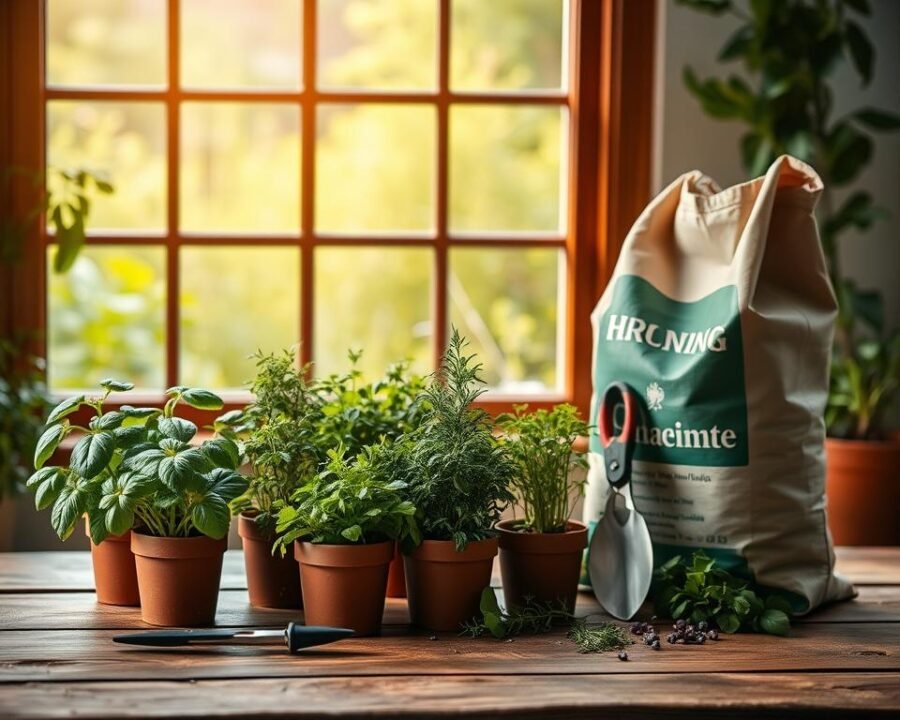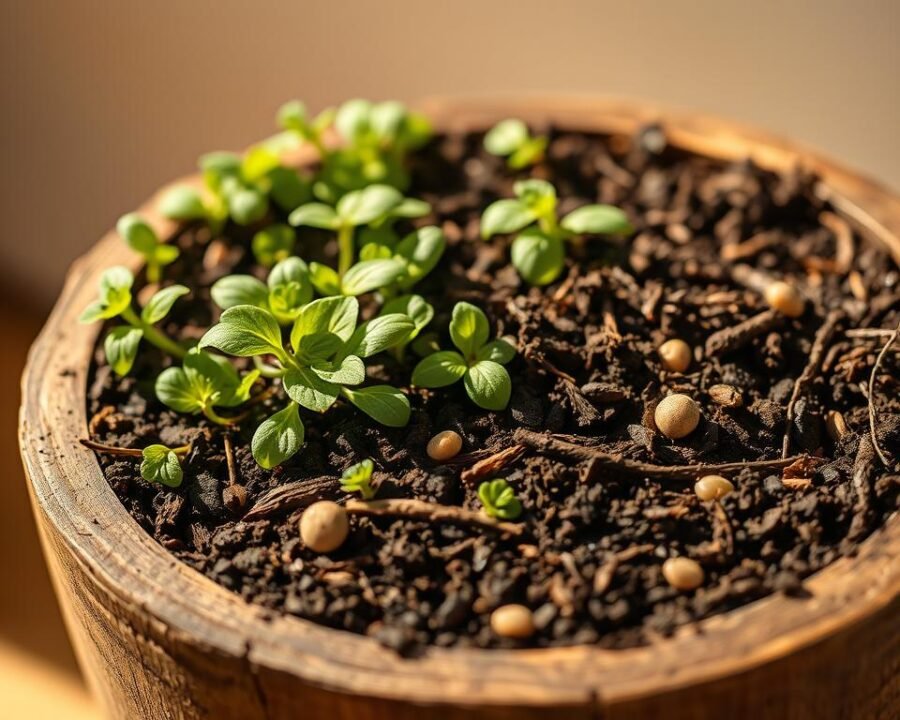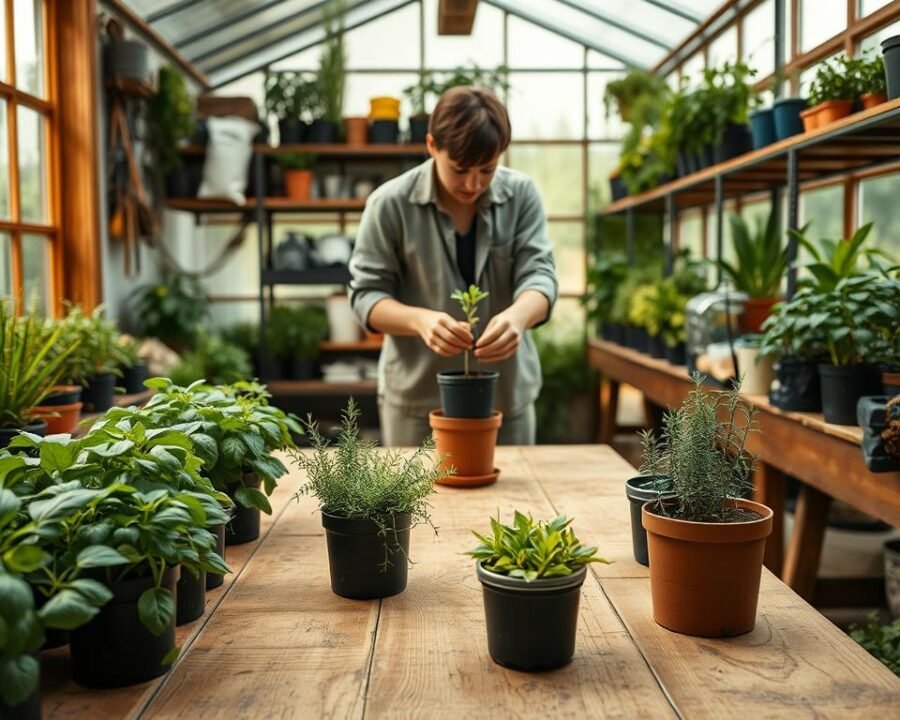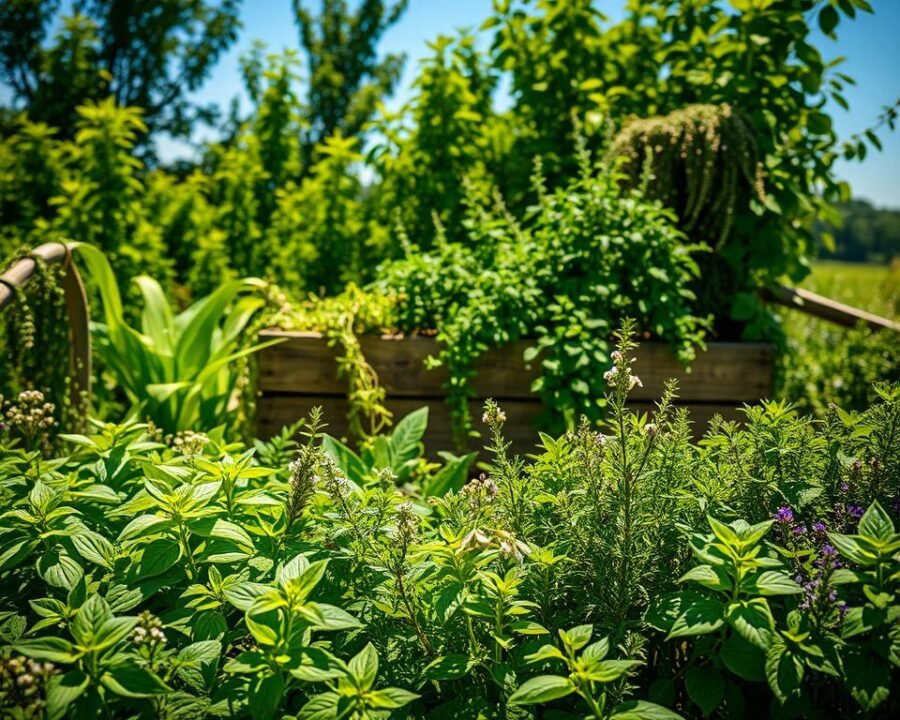There’s something magical about plucking fresh herbs right from your garden. The aroma, the taste, and the satisfaction of nurturing life—it’s a joy many are discovering. More households are embracing this rewarding hobby, blending culinary creativity with natural wellness.
Whether you’re a beginner or a seasoned gardener, our guide simplifies the process. We’ll walk you through selecting the right varieties, planting techniques, and seasonal care. With the right approach, you can enjoy fresh flavors year-round.
Imagine garnishing dishes with homegrown basil or brewing soothing mint tea. It’s easier than you think. Let’s dive in and transform your space into a thriving green haven.
Key Takeaways
- Home herb gardens are gaining popularity for freshness and health benefits.
- Proper care ensures year-round harvests, even in small spaces.
- Choosing the right varieties maximizes flavor and growth success.
- Seasonal adjustments keep your plants thriving in any climate.
- Expert tips help beginners avoid common pitfalls.
Why Grow Your Own Herbs? Fresh Flavor at Your Fingertips
Nothing beats the vibrant taste of just-picked basil in your favorite dishes. Supermarket herbs often lack the punch of homegrown varieties, wilting long before they hit your plate. With your own garden, every leaf bursts with flavor—no preservatives needed.
*Our rosemary outlasted three store-bought plants,* shares home gardener Lisa T. Her thriving bush now seasons soups year-round. Unlike limp grocery-store sprigs, homegrown fresh herbs stay lively for weeks.
Beyond taste, there’s real savings. A $3 clamshell of basil yields one meal, while a $4 plant provides months of harvests. Multiply that across thyme, mint, and oregano—your kitchen stays stocked for pennies.
Tending herbs also soothes the mind. Studies show gardening lowers stress hormones. Snip lavender for tea after a long day, or brush your fingers through fragrant lemon balm. Even indoor pots purify air, filtering toxins while adding greenery.
From pesto to herbal remedies, your windowsill or backyard becomes a powerhouse. *Thyme for coughs, mint for digestion*—nature’s pharmacy thrives within reach. Why settle for less when you can cultivate abundance?
How to Grow Herbs and Plants Everyone Is Using: Getting Started
Your herb garden’s success hinges on two decisions: what to grow and where to get it. Whether you crave basil for pasta or chamomile for tea, matching plants to your space ensures lush results.

Picking the Perfect Varieties
Sunlight dictates your lineup. Rosemary thrives in full sun, while parsley prefers shade. Use this guide to match greens to your conditions:
| Herb | Sun Needs | Best For Beginners? |
|---|---|---|
| Basil | Full sun | Yes (needs warmth) |
| Mint | Partial shade | Yes (spreads aggressively) |
| Cilantro | Full sun | No (bolts easily) |
| Chives | Partial shade | Yes (cold-hardy) |
Pro tip: Start with forgiving picks like mint or chives. Basil’s a crowd-pleaser but demands consistent watering.
Finding Quality Seeds and Plants
Skip big-box stores—their plants often carry fungicides. Trusted brands like Baker Creek or Botanical Interests offer organic, non-GMO seeds. At local nurseries, ask growers:
- Were these treated with chemicals?
- What’s the ideal planting time here?
- Any pest issues to watch for?
“My dill sprouted in days from Botanical Interests’ packets—way healthier than grocery-store starts.”
Store extra seeds in airtight jars in the fridge. Most remain viable for 2–3 years. Now you’re ready to grow herbs like a pro!
Preparing the Perfect Home for Your Herbs
Healthy roots start with the right environment—let’s build it together. The secret to lush, flavorful harvests lies in two essentials: soil that nourishes and containers that protect. Nail these, and your garden will thrive with minimal fuss.

The Ideal Soil Mix for Thriving Herbs
Not all dirt is created equal. Mediterranean varieties like rosemary crave sandy blends, while basil thrives in richer mixes. Try this foolproof recipe:
- 1 part topsoil (structure)
- 1 part compost (nutrients)
- 1 part paver sand (drainage)
- Handful of worm castings (microbes)
Pro tip: Skip bagged “potting soil”—it often retains too much moisture. One gardener’s sage withered in commercial mix but rebounded in this DIY blend.
Selecting Containers with Proper Drainage
Terracotta breathes better than plastic, preventing soggy roots. But lightweight resin works for balconies. Key features:
| Material | Pros | Cons |
|---|---|---|
| Terracotta | Airflow, stylish | Heavy, breaks easily |
| Plastic | Cheap, lightweight | Traps heat, less durable |
Layer gravel at the pot’s base to prevent clogging. Upcycle mason jars or tin cans—just drill holes! Mint’s shallow roots fit in a repurposed colander, while parsley needs 12-inch depth.
Planting Your Herbs: Step-by-Step
Transforming tiny seeds into lush greenery begins with smart planting techniques. The right approach ensures vigorous growth and bountiful harvests. Let’s explore two proven methods to kickstart your garden.

Seed Starting Versus Propagation
Some varieties sprout easily from seed, while others root better from cuttings. Basil germinates in 5-10 days, making it ideal for beginners. Woody herbs like rosemary often propagate faster from stem cuttings.
Try these rooting boosters for cuttings:
- Willow water (natural rooting hormone)
- Honey (antibacterial properties)
- Cinnamon powder (prevents fungal issues)
“My basil cuttings rooted 3 days faster using willow water from backyard branches.”
Space Planning for Healthy Plants
Proper spacing prevents competition for nutrients and light. Basil needs 12 inches between plants for bushy growth. Compact varieties work well in vertical gardens—try stacking planters on sunny walls.
Smart companion pairings:
| Herb | Good Neighbors | Avoid Planting With |
|---|---|---|
| Basil | Tomatoes, oregano | Rue, sage |
| Mint | Cabbage, peas | Parsley |
Leggy seedlings? Bury stems deeper when transplanting. This strengthens the plant and encourages root development. With these techniques, your garden will flourish in no time!
Caring for Your Herb Garden
Mastering care techniques keeps your garden thriving all year. Small adjustments to water and sunlight prevent common issues like wilted leaves or stunted growth. Let’s explore how to nurture your plants for maximum flavor and vitality.
Watering Do’s and Don’ts
Rosemary thrives on neglect, while basil craves consistent moisture. Use the finger test—insert it an inch deep. If dry, it’s time to hydrate. Overwatering drowns roots, so ensure pots drain well.
Try these pro tips:
- Water in the morning to reduce evaporation.
- Use DIY self-watering spikes for vacations (cut a plastic bottle, insert a cotton wick).
- Group plants by water needs to simplify routines.
“My basil perked up instantly after switching to morning watering—no more droopy leaves!”
Sunlight Requirements by Herb Type
South-facing windows deliver the strongest sunlight indoors. Outdoors, track shade patterns—some varieties burn easily. Here’s a quick guide:
| Herb | Daily Sun Needs | Signs of Stress |
|---|---|---|
| Basil | 6–8 hours | Yellowing, crispy edges |
| Thyme | 4–6 hours | Leggy stems, pale leaves |
| Parsley | 3–4 hours | Wilting in afternoon sun |
In winter, supplement with LED grow lights (12–14 hours daily). Rotate pots weekly for even exposure. With these strategies, your garden stays lush through every season.
Seasonal Herb Gardening Tips
Timing is everything when cultivating a vibrant garden. Different months bring unique challenges and opportunities for your green companions. Let’s explore how to keep them thriving through scorching summer days and chilly winter nights.
Summer Herbs That Thrive in Heat
Mediterranean varieties like oregano, thyme, and rosemary laugh in the face of sweltering temperatures. Their woody stems and small leaves conserve moisture, making them ideal for hot summer months.
Follow this July care checklist for robust growth:
- Mulch with straw to retain moisture and suppress weeds
- Inspect leaves weekly for aphids and spider mites
- Harvest in early morning when essential oils peak
“My Greek oregano produces twice as many leaves since I started morning harvesting—the flavor difference is incredible.”
| Heat-Loving Herb | Water Needs | Best Harvest Time |
|---|---|---|
| Rosemary | Every 10-14 days | Before flowering |
| Thyme | Weekly | When stems are 6″ tall |
| Oregano | When soil is dry | Mid-morning |
Winterizing Your Perennial Herbs
Hardy perennial varieties like sage and lavender need protection when frost arrives. The key is gradual acclimation—don’t wait until the first freeze.
Zone-specific overwintering strategies:
- Zones 3-5: Move containers to unheated garages
- Zones 6-7: Mulch heavily with shredded leaves
- Zones 8+: Prune lightly and reduce watering
Recognize dormancy signs—yellowing leaves and halted growth mean it’s time to stop watering. For more detailed perennial care, explore this seasonal growing guide.
Pro tip: Build a simple cold frame using old windows to shelter tender herbs like bay laurel. This creates a microclimate that mimics spring conditions all winter long.
Harvesting and Using Your Herbs
Harvesting homegrown herbs unlocks flavors store-bought versions can’t match. Timing and technique matter—snip leaves in the morning when essential oils peak for intense aroma. Whether garnishing dishes or crafting teas, your garden’s bounty shines with simple know-how.
Mastering the Art of Picking
Scissors prevent bruising delicate stems, while pinching encourages bushier growth. For basil, cut above leaf nodes to spur new branches. Woody herbs like rosemary need sharp snips to avoid tearing.
Pro tip: Harvest chive flowers just as they bloom—toss petals into salads for a mild onion kick. Avoid over-picking; never remove more than ⅓ of a plant’s foliage at once.
Preserving Your Harvest
Freezing herbs in olive oil ice cubes retains freshness for soups. Dehydrators work best for thyme and oregano—set to 95°F for 12 hours. Compare flavor retention methods:
| Method | Best For | Flavor Retention |
|---|---|---|
| Fresh | Garnishes, salads | 100% (short-term) |
| Dried | Spice blends | 70–80% |
| Frozen | Cooking oils | 90% (6 months) |
For home infusions, sterilize jars to prevent mold. Sun-dried tomato oil needs refrigeration, while rosemary oil stays shelf-stable for weeks. Always label with dates!
Troubleshooting Common Herb Problems
Even the healthiest gardens face challenges—here’s how to spot and solve them. Early detection prevents minor issues from becoming harvest-ruiners. We’ll decode leaf signals and share earth-friendly fixes.
Identifying Nutrient Deficiencies
Yellow leaves often scream nitrogen hunger, while purple stems hint at phosphorus lack. Spotting versus streaking reveals different needs:
- Uniform yellowing: Nitrogen deficiency (add compost tea)
- Yellow between veins: Iron shortage (adjust soil pH)
- Brown edges: Potassium deficit (banana peel fertilizer)
Grab a soil test kit from your local store. The $15 Luster Leaf model gives accurate pH and NPK readings. For quick fixes, crushed eggshells boost calcium instantly.
Natural Pest Control Solutions
Aphids hate marigolds—plant them near basil as bodyguards. For stubborn infestations, whip up this neem oil spray:
- Mix 1 tsp cold-pressed neem oil with 1 quart water
- Add 3 drops dish soap as emulsifier
- Spray leaves weekly, focusing on undersides
Boost air circulation to deter fungus gnats. A small fan near indoor setups works wonders. For outdoor spaces, build a bug hotel with bamboo sticks—ladybugs will move in to devour mites.
“My mint rebounded after spacing plants near a sunny window. The airflow stopped white mold in its tracks.”
Conclusion: Your Lush Herb Garden Awaits
The journey from seed to harvest brings endless rewards. From your first snip of basil to winterizing sage, each step deepens your connection to home-grown flavor. Celebrate milestones—crisp mint for tea, fragrant rosemary for roast dinners.
Share the joy! Swap seeds with neighbors or join local gardening groups. Imagine trading Thai basil for lemon balm—your herb garden becomes a community treasure.
Ready for more? Explore hydroponics—an easy grow method for year-round abundance. Your caprese salad, garnished with just-picked leaves, is just the beginning.
Snap a photo of your first harvest and tag #MyHerbJourney. We’d love to see your green haven thrive!
